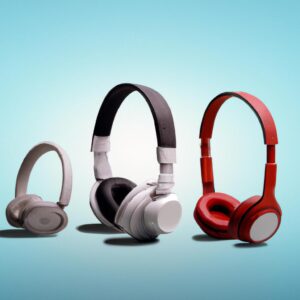Hear What You’ve Been Missing: Over-Ear vs. In-Ear vs. On-Ear Headphones Showdown

Headphones come in a variety of shapes and sizes, and all have their own distinct advantages and disadvantages. In this guide, we will be looking at three of the most common types of headphones: Over-Ear, In-Ear, and On-Ear.
Over-Ear headphones are the classic type of headphones that many people are familiar with. They generally have large, cushioned earcups that completely go around your ears and provide excellent noise isolation. They typically provide the highest sound quality of the three types of headphones, but they tend to be bulkier and heavier than In-Ear or On-Ear models.
In-Ear headphones are small, cylindrical earbuds that fit inside your ear canal. They are the least bulky type of headphones and are often used in active and outdoor settings where they require less maintenance and can be easily stored. In-Ear headphones also tend to provide good sound quality, but they are often not as good at blocking out background noise as Over-Ear models.
On-Ear headphones are similar to Over-Ears, but instead of going completely around your ears, they rest on top of them. These are also often referred to as “supra-aural” headphones. Like In-Ear models, they tend to be less bulky than Over-Ear models, but they don’t provide the same level of sound quality due to their smaller size. However, they are great for portable listening as they are lightweight and allow you to stay aware of your surroundings.
Stay tuned as we compare the sound quality, comfort levels, noise isolation, durability, and cost of Over-Ear, In-Ear, and On-Ear headphones. We will also provide a comprehensive comparison table that will help you make an informed decision when selecting the right pair of headphones for your needs.
When discussing the sound quality of headphones, the main difference between Over-Ear, In-Ear and On-Ear headphones are their size. Over-Ear headphones are the largest of the three and they create an enveloping sound around the head that can produce a wider soundstage for a more immersive experience. They typically offer strong bass and have the ability to more accurately capture the detail in music. The downside to Over-Ear headphones is that they tend to be heavier and bulkier than their smaller counterparts, making them less portable.
In-Ear headphones are the smallest of the three and they create a tight seal around the ear canal, which leads to better noise isolation. They can pack a punch and sound great with the right fitting tips, but can be uncomfortable for some people due to their shallow fit.
On-Ear headphones usually provide a balance of comfort and portability, though not always with the same sound quality. They don’t typically provide the same noise isolation as Over-Ear or In-Ear models, but they are usually lighter and more comfortable than Over-Ear headphones.
When comparing the sound quality of each type of headphone, it’s important to take into account your own personal preferences. Consider what type of genre you intend to listen to and how much noise isolation you need. Experimenting with different types is the only way to determine which will give you the best experience.
Compare Sound Quality of In-Ear Headphones
In-ear headphones offer great sound quality and are available in a range of prices from budget-friendly to premium-grade. When comparing different types of in-ear headphones, there are several features to consider, including sound quality, fit, comfort level, and noise isolation.
When it comes to sound quality, In-Ears usually boast excellent soundstage and clarity, though it is often slightly less than what you might hear with Over-Ear or On-Ear headphones. They also tend to have more dynamic bass response than other types of headphones, offering punchy bass lines and deep internal resonance. However, this can sometimes come at the expense of soundstage, as the drivers may not be big enough to keep up with wider soundscapes.
In terms of fit, In-Ears are designed to sit snugly in the ear canal and stay there thanks to their wingtip design. This ensures a secure fit and better noise isolation, as well as improved sound performance due to a tighter seal. Comfort level varies depending on the user’s ears, but generally speaking, In-Ears are quite comfortable for extended listening sessions.
Finally, In-Ears offer the advantage of better noise isolation than other types of headphones. This is due to their snug fit in the ear canal, which keeps out external sounds and gives users excellent audio quality even in noisy environments.
Compare Sound Quality of On-Ear Headphones
On-ear headphones, also known as supra-aural headphones, sit on top of the ear rather than around it like their over-ear counterparts. They offer a balance between sound quality and comfort, typically providing excellent sound isolation from external noise even in noisy environments. They usually come with smaller drivers than most over-ear headphones, but the sound quality is still considered to be high.
When comparing the sound quality of on-ear headphones to other types of headphones, you’ll want to consider factors such as frequency response, sensitivity and impedance. Frequency response is the range of sounds the headphones can deliver. The higher the frequency response, the better the sound quality will be. Meanwhile, sensitivity measures how loud the headphones can get when played at a given volume, while impedance is the measure of electrical resistance in a pair of headphones. Generally, higher impedance will provide better sound quality.
Pros of on-ear headphones include excellent sound isolation from external noise and good sound quality overall. On-ear headphones are also usually quite lightweight and portable, so they can be carried around easily. However, there are some cons to consider as well. Not all on-ear headphones offer great comfort due to their design, and they may not be suitable for long listening sessions. Additionally, some on-ear headphones may cause ear fatigue after extended use.
Comfort Comparison: Over-Ear vs. In-Ear vs. On-Ear
Are you trying to decide between over-ear, in-ear and on-ear headphones? All three types offer great sound quality and have their own unique benefits, but comfort is always important. Let’s take a look at the features of each type and how they compare when it comes to comfort.
Over-Ear Headphones
Over-ear headphones are large and can be quite bulky. They often have thick padding on the earcups that make them quite comfortable to wear. They fit nicely around your ears and provide an excellent level of noise isolation. Some people find that over-ear headphones can get a bit hot after extended wear, since there is no airflow over your ears.
In-Ear Headphones
In-ear headphones, also known as earbuds, provide a much tighter fit than over-ear headphones. They are tiny and lightweight so they can easily fit into tight spaces. The sound is usually great, and the noise isolation is often superior to over-ear headphones. The trade-off is that some people find in-ears uncomfortable to wear for long periods of time.
On-Ear Headphones
On-ear headphones sit on your ears rather than around them. They don’t provide the same level of noise isolation as the other types, but they are usually more comfortable for long periods of wear. Since they are smaller than over-ear headphones, they usually have less padding and are not as good at blocking out external noise.
Conclusion
When it comes to comfort, each type of headphone offers its own unique benefits. Over-ear headphones provide excellent noise isolation and are usually quite comfortable to wear, while in-ear headphones provide better sound quality and noise isolation but can cause discomfort. On-ear headphones are lightweight and small and can be comfortable for long periods, but they don’t provide the same level of noise isolation.
Comparison of Noise Isolation – Over-Ear vs. In-Ear vs. On-Ear
Noise isolation is an important feature when it comes to choosing the right type of headphones for you. Over-ear headphones offer the best noise isolation as they cover your entire ear and provide a seal over the outside world. In-ear headphones are similar, but they are positioned inside the ear canal, providing a more intimate seal. Finally, on-ear headphones sit on top of the ear and provide moderate noise isolation.
The amount of noise isolation you need will ultimately depend on how much outside noise you want to block out and the environment you plan to use your headphones in. If you live in a noisy area, then the extra noise isolation of over-ear or in-ear headphones could be beneficial. However, if you prefer more open sound and don’t mind a bit of outside noise, on-ear headphones might be better for you.
It’s also worth noting that active noise cancellation is available with some over-ear and on-ear headphones, which helps block out even more ambient noise. This technology uses microphone feedback to identify surrounding noise and counteract it with sound waves generated by the headphones. Be aware that this can add to the cost of the headphones, but could provide the extra isolation you need.
Comparison of Durability – Over-Ear vs. In-Ear vs. On-Ear
When it comes to durability, most people often think that the sturdiest option is an over-ear cup design, as these headphones typically have a thicker and more durable construction than in-ear and on-ear designs. The main disadvantage is that they are usually heavier, and the pressure of the ear cups on the ears may become uncomfortable after prolonged use. Over-ear headphones are usually designed with higher quality materials to ensure greater durability.
In-ear headphones are less durable than over-ear headphones, as they have a much smaller frame that can be easily damaged. However, they are also much lighter and less cumbersome. In-ear headphones are generally quite affordable and provide excellent sound quality when used correctly. They are also much less likely to slip off your head than over-ear headphones.
On-ear headphones tend to be the least durable of the three types of headphones. They are often made from lightweight materials, so they can be easily crushed or broken. However, they are lightweight, discreet and well-suited for travel or commuting. On-ear headphones are also much cheaper than over-ear and in-ear headphones, making them an attractive choice for those on a tight budget.
Cost Comparison – Over-Ear vs. In-Ear vs. On-Ear
When it comes to cost, headphones range from very cheap to very expensive. We will compare the different types of headphones to determine which one provides the best cost-value ratio.
Over-Ear headphones tend to be more expensive than the other two varieties, but they also provide more features and better sound quality. Prices can start at around $30, but can skyrocket up to $500 or more for the high-end models.
In-Ear headphones are usually the cheapest option, with prices starting at around $10. High-end models with noise-cancelling and wireless capabilities can reach up to $200.
On-Ear headphones generally offer a good balance between price and features. Prices range from $15 to $150 depending on the model and features.
Summary of Headphones Showdown – Over-Ear vs. In-Ear vs. On-Ear
After a comparison of sound quality, comfort levels, noise isolation and durability for Over-Ear, In-Ear and On-Ear headphones, it’s clear that each type of headphone is designed to suit its purpose and provide advantages in certain scenarios.
Over-Ear headphones generally provide the best sound quality, comfort and noise isolation, however they are often the most expensive option. In-Ear headphones offer more portability and are widely available at affordable prices. On-Ear headphones offer less sound quality than the other two but can still provide good value for money and are the most lightweight option.
Overall, the best type of headphones for you will depend on what you need them for and how much you’re willing to spend. Ultimately, it’s key to consider what features are important to you and your lifestyle when making a decision.
Technical Specifications Comparison Table
We have compiled a detailed comparison table to better help you understand the sound, comfort, durability, and cost of each type of headphone. Here is an overview of the technical specifications for the three types:
- Over-Ear Headphones: These headphones typically feature larger drivers (which produce sound) compared to other types of headphones. They also allow for a greater amount of noise isolation due to their larger ear cups.
- In-Ear Headphones: These headphones feature smaller drivers and are made to fit in the ear canal. The small size means that they offer less sound quality and noise isolation than over-ear headphones.
- On-Ear Headphones: These headphones feature similar drivers as over-ear headphones but the design is much smaller. They offer less sound quality and noise isolation than over-ear headphones.
Below is a technical specification comparison table to help you compare the sound, comfort, durability, and cost of each type of headphone.
The Headphones Showdown between Over-Ear, In-Ear, and On-Ear headphones is a close match. Each one offers its own unique advantages and disadvantages. When choosing the best type for you, consider factors such as sound quality, comfort level, noise isolation, durability and cost.
Over-Ear headphones are attractive in terms of sound quality, and also offer good noise isolation and durability which makes them ideal for long-term use. They are also quite expensive compared to the other two types.
In-Ear headphones, on the other hand, are lightweight and compact making them more suited for the active lifestyle. Furthermore, they provide great sound quality, good noise isolation and are relatively affordable.
On-Ear headphones provide a good balance between sound quality, comfort level and cost. They are more affordable than Over-Ear headphones, yet still provide good sound quality and noise isolation.
Overall, all of the headphones offer different features and benefits that cater to different lifestyles. When choosing the right type for you, remember to consider all of the factors in theHeadphones Showdown such as sound quality, comfort level, noise isolation, durability and cost. With this information, you can make the best choice for your individual needs.
Call to Action: Suggesting Products to Purchase
Now that we’ve discussed the different types of headphones and which features are most important, let’s talk about which products you can purchase to get the best audio experience. After careful research, these are the top recommended headphones for each category:
- Over-Ear Headphones – Bose QuietComfort 35 II
- In-Ear Headphones – Sennheiser Momentum True Wireless
- On-Ear Headphones – Sennheiser HD 4.30i
We suggest researching additional products that fit your audio needs before purchasing. Do your best to read reviews and try out demo models if possible. Don’t forget to consider the budget, sound quality, comfort level, noise isolation, and durability when making your purchase.
comments: 0






